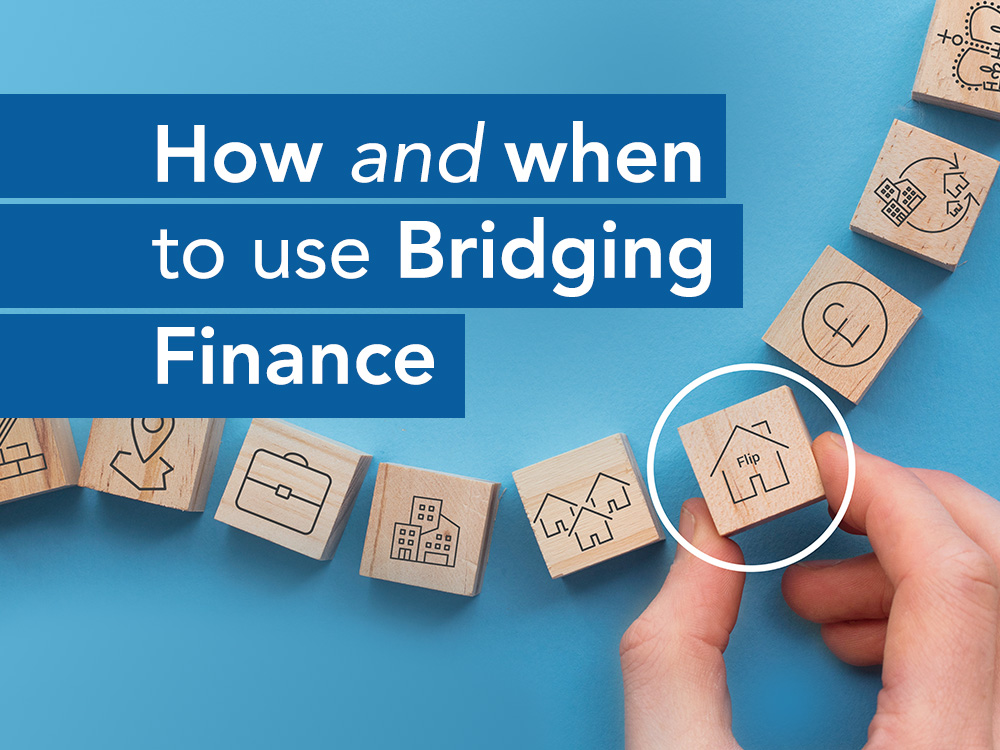On this page
How and when to use bridging finance 1. Completing a large development in Surrey 2. Downsizing to a retirement apartment 3. Extending a fishing business in Cornwall 4. Paying for an elderly relative's nursing home fees 5. Buying a retirement property in Spain 6. Bridging loan needed to fund divorce settlement 7. Funding inheritance tax following parent's death 8. Buying an unmortgageable property 9. Buying a property at auction 10. Refurbishing and converting a semi-commercial property 11. Converting multiple barns on a family-owned farmHow and when to use bridging finance
The stereotypical idea of bridging finance as a way to tide you over between buying and selling residential property – very much the most common use of bridging loans in the late 20th century – is now well out of date.

Today, bridging finance is used more by property investors than by residential homeowners. Its use has spread far beyond its original parameters, helping people to conclude deals, pay off debts, acquire new assets and make investments previously out of their reach.
Here are 11 examples of the variety of purposes that bridging loans can be used for.
1. Completing a large development in Surrey
A couple who were renovating a large property in Surrey, with seven bedrooms and 20 acres of land, needed £1.2 million to complete the work. They needed funds quickly to pay contractors and finish the work, so they turned to bridging finance.
The maths worked like this: the property was worth £5 million in its current condition, but had a Gross Development Value of £8 million once it was renovated. To complicate matters, the owners needed to borrow money for almost two years – longer than a normal bridging loan term.
To minimise the interest they paid, the couple agreed to a staged bridging arrangement with their lender, taking out three tranches of £400,000 and paying their contractors as the bills came in, rather than taking out the full £1.2 million in one go, which would have been more expensive.
In the end their bridging loan enabled them to finish the work in good time, then sell the property to repay the loan and emerge with a healthy profit.
2. Downsizing to a retirement apartment
A couple in Birmingham found an ideal apartment for their retirement, close to their relations and all the amenities they needed, so they enquired about buying it. The trouble was, the apartment was in high demand and other buyers were able to move quickly.
To conclude their purchase, the couple took out bridging finance so that they could make an immediate offer. If they left things for another couple of weeks, they would be in danger of losing the purchase.
Their existing property was valued at £600,000 whereas this retirement apartment was on the market for £250,000. They took out a bridging loan for £200,000 over a 12-month term with interest charged at 0.5 per cent per month, enabling them to buy the apartment.
Following this purchase, the couple sold their existing property and were easily able to repay the bridging loan.
3. Extending a fishing business in Cornwall
A family-owned fishing business in Falmouth, Cornwall, had the opportunity to buy a second-hand trawler. There was only a narrow window of opportunity to make the purchase since other buyers were interested and a financing company needed several weeks to reach a decision.
Through taking out a bridging loan, the family were able to complete the acquisition of the trawler, and then put in place longer-term financing further down the line, in order to repay the bridging loan.
The fishing business was able to expand and thrive, through taking advantage of a rare opportunity.
4. Paying for an elderly relative’s nursing home fees
When an elderly woman moved into a care home, she planned to pay for the fees by selling her property. However, the fees came due within a short time, whereas the home would take some months to sell.
The woman’s son arranged a bridging loan to settle the outstanding care home fees, allowing her to stay in the care home while her property could be sold in an orderly way, rather than accepting a lower price during a rushed sale.
5. Buying a retirement property in Spain
A couple living in South London in a property worth £800,000 found a villa in Spain to buy for their retirement. To secure the Spanish villa, they needed to put down a £150,000 deposit, but their London home was taking longer to sell than they expected.
To achieve the purchase, the couple took out a bridging loan of £150,000 against their London home. This enabled them to gain an Agreement in Principle to give the sellers in Spain, securing the property for them.
6. Bridging loan needed to fund divorce settlement
With a valuable home and a buy-to-let property, an owner in Leicestershire needed to raise £550,000 to make a divorce settlement. He initially struggled to find this sum, due to a below-market valuation of his properties. However, after contacting a bridging finance broker, who could introduce him to a wider selection of lenders, he was able to source a loan of £550,000 based upon a more up-to-date valuation.
Without the bridging loan, the divorce settlement could not be finalised, meaning that neither of the two parties could move on with their lives and buy other places to live. So the bridging finance proved instrumental in unlocking their future plans.
7. Funding inheritance tax following parent’s death
A young woman who lived in her mother’s home needed to pay inheritance tax on the property once her mother died. Yet she had no resources to pay this from her own income, and the tax had to be paid in advance of the property passing to her.
After failing to get a loan from finance brokers, due to her lack of funds and the fact that the property was not yet in her name, she turned to a bridging finance company. This proved to be a lifeline for the woman, since it allowed her to pay the inheritance tax, renovate the property in preparation for sale and gave her sufficient resources to live on. The bridging loan of £250,000 included rolled up interest, so she did not have to make monthly payments during the course of the loan.
8. Buying an unmortgageable property
A high-income couple with their own business found a large home with great views over the sea in Sussex costing £900,000. However, it had no bathroom and was in a very poor condition – no traditional mortgage provider would touch it.
Although bridging finance companies were prepared to offer a loan of £750,000 to enable the couple to complete renovations, the buyers were concerned that the work could take longer than the 12-month period usually offered for a bridging loan.
Instead, they negotiated a 24-month loan on a low-interest rate, enabling them to plan ahead with the security that the renovations would be complete in time to refinance with a traditional mortgage.
9. Buying a property at auction
A young professional whose family owned a string of corner shops wanted to branch out into property letting. He attended some auctions and then, once he’d found a suitable property, arranged bridging finance of £250,000 to help him buy a £500,000 two-bedroomed apartment in Southend, Essex, which he planned to renovate, let out and remortgage on a buy-to-let deal.
His total fees and interest rate payments came to £12,000 over the six months between acquisition and remortgage, delivering a substantial and ongoing profit once the apartment was let out on a long-term basis.
10. Refurbishing and converting a semi-commercial property
A semi-commercial property with a florist on the ground floor and five one-bed apartments on upper floors was on sale for an ‘on title’ value of £1.2 million in central Manchester. The building’s ‘on market’ value was £1.6 million, so the buyer was able to arrange bridging finance for the entire £1.2 million purchase price.
Once acquired, the buyer converted each of the one-bed apartments into two-beds, extended the lease on the florist, remortgaged to pay back the bridging loan and let out the apartments. The building now attracted an ‘on market’ valuation of £2.4 million.
11. Converting multiple barns on a family-owned farm
A family who owned an unencumbered farm in Wales had a cluster of barns on the edge of their land which they wanted to develop into holiday lets. As the children of the family wanted to protect the parents’ home they didn’t want to use that as security. Instead, they were able to separate the land title of the barns from the family home. With this in place, they were able to raise the funding they required from only using the barns as security, and as that was to be used as a business, they were able to obtain an unregulated bridging loan.
After further consideration and working out the full anticipated development costs, they decided to also split and additional 10 acres of adjacent land from the farm title deeds, which for bridging purposes could be bundled into the security to provide enough funds for the entire build. After the loan was drawn in 3 stages and the development was successfully completed, the family were able to quickly refinance just the barn development onto a buy-to-let mortgage ensuring that the interest on the bridging loan was minimised. The additional 10 acres of land were then free of any charges and, should the family choose to, it could be used again to secure finance for potential alternative incomes such as a farm shop and cafe. The family successfully diversified the farm’s revenue stream.





